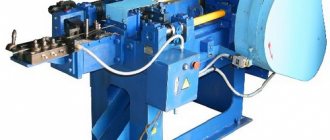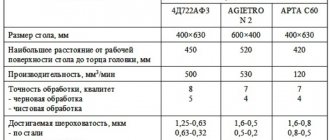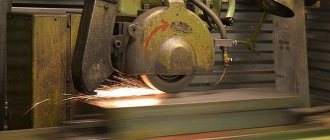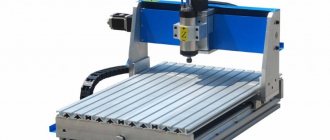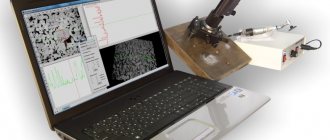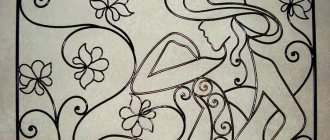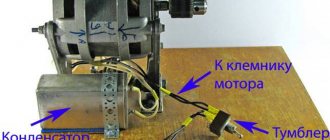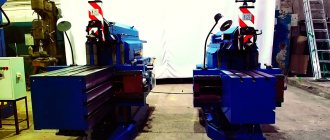DESCRIPTION OF CNC PROGRAM CAPABILITIES:
- The CNC program has a simple and user-friendly interface, displayed on a 15-inch color touch screen. There is a USB port for connecting flash drives. The internal memory of the machine can have up to 100 folders, each folder with up to 50 programs.
- Optimizing machine operation - using simultaneous movement of several nodes to increase productivity. At the same time, the CNC program allows you to interpolate all servo axes, that is, when several axes move simultaneously, their speeds are automatically adjusted.
- The CNC program allows you to work in several modes: Manual (each drive operates separately at the press of a button); Training mode (the program remembers the operator’s actions); Semi-automatic (operations are performed step by step, according to a CNC program); Automatic (operations are performed non-stop, according to the CNC program)
- Adjustment of speeds of all drives (feed, rotation and bending speeds).
- Electronic self-diagnosis with error display on the screen.
- Possibility of connecting automation devices.
A machine for bending reinforcement is equipment that is widely in demand in modern construction. Depending on the required performance, such units can have an electromechanical (less often hydraulic) drive, be controlled manually, or operate in an automated cycle. The drive power of such equipment is low, since bending processes do not require large energy consumption.
Range of fittings used
This type of rolled steel, in accordance with the requirements of GOST 5781, is supplied in a hot-rolled state. With a cross-sectional diameter of up to 27 mm, this can be rods and wire; above 27 mm - only rod. Reinforcing profiles with a square cross section are much less common. The steel reinforcement profile is special, with surface notches of various types and intensity.
The choice of steel grades intended for bending reinforcement is also limited. Depending on the operating conditions, the reinforcement is divided into 4 classes, and each corresponds to certain steel grades:
- For fittings of class A-I (A240) - carbon steel of ordinary quality, type St.3 according to GOST 380 (range of profiles from 6 to 40 mm);
- For fittings of class A-II (A300) - carbon steel of ordinary quality, type St.5 according to GOST 380 (range of profiles from 6 to 80 mm);
- For reinforcement of class Ac-II (Ac300) - low-carbon high-quality construction steel type 10GT or 18G2S according to GOST 27772 (range of profiles from 10 to 40 mm);
- For reinforcement of class A-III (A400) - medium-carbon high-quality construction steel types 32G2R, 35GS according to GOST 27772 (range of profiles from 6 to 40 mm).
The choice of class depends on the operational loads to which the reinforced concrete structure of the structure is subjected, since only the metal component absorbs all operating stresses. The laying of corner reinforcement elements is almost always required, since the stresses that arise in the corners of walls, foundations, etc. are especially high.
The ductility of all of the above grades of hot rolling steel is in the range of 65...70%, which makes it possible to use cold plastic deformation processes for their processing. In particular, even the most durable reinforcing steels of class A400 allow bending without cracking at angles up to 90 0 (without taking into account the natural springback of the material). At the same time, the strengthening of steels is relatively small.
In addition to rods, the production of reinforcement requires binding wire. Its diameter usually does not exceed 3...4 mm. Unlike rods, tying wire always has a strictly round profile and is made of soft plastic steel grades St.3 or (for more critical reinforced concrete structures) from steel 08kp according to GOST 1050.
Thus, the choice of the appropriate type of bending equipment is determined by the physical and mechanical characteristics of the material and the required productivity.
Rod driven machines
The characteristic features of the plastic deformation technology, which is implemented on such equipment, are the sequential implementation of cutting transitions and subsequent bending, since stamping is carried out from a continuous material. Therefore, the number of transitions on such machines is at least two (some models also provide for editing and calibration of cut rod blanks). Non-automated equipment (for example, a reinforcement bending machine SGA50) is more often used for bending reinforcement with a diameter of over 12...16 mm. Specialized machines are used to bend wire reinforcement.
We will consider machines for cutting and bending reinforcement using the example of bending and cutting machines SB6-12 (PRC), manufactured under license from the German company Schelle. The unit structure includes the following components:
- Reception cassette.
- Workpiece feeding mechanism (roller type).
- Drive of the cutting mechanism.
- Cutting slide.
- Adjustable stops and clamps.
- Pneumatic compressor.
- Bend sliders.
- Electric motor.
- Computer control panel with built-in display.
- Dropper.
The machine for bending reinforcement works as follows. First, the operator enters a program for bending the workpiece, after which the computer sets the required length of the cut of the original workpiece, as well as the stroke of the bending slider, taking into account the springing of the material and the geometric configuration of the finished product. When the feed mechanism is turned on, the bar is simultaneously straightened. When feeding all the way, the cutting mechanism drive is turned on, the measured workpiece is cut off and advanced by the end part of the material to the bending position, where it is fixed. At the same time, the compressor creates the pressure necessary to move the bending slider until the material completely compresses the matrix, the profile of which corresponds to the shape of the final part. When the slider moves in reverse, the ejector removes the product from the processing zone, after which the operator removes the finished part into a container.
Read also: How to cut out of plywood with an engraver
The SB6 model performs flat bending, while the SB12 machines are also capable of spatial bending of the material. The equipment can also operate in fully automatic mode, then the operator’s only function is to thread the next bar into the cassette.
Manual benders with cutting and straightening functions can also operate in a similar manner.
Fully automated machines (for example, AlbaDesa made in Italy) are considered a further development of this type of equipment. Here, a coil is used as a range of source material, and the stamping process is carried out continuously. Productivity increases, and the overall dimensions of the equipment, on the contrary, decrease (the coil unwinder is more compact than the cassette).
In the practice of producing bent reinforcement products, it is sometimes impractical to purchase automated equipment. The bending machine for fittings is very compact, simple and has a significantly lower cost. The limitation of this technology is the need for preliminary cutting of workpieces “to size”.
A typical representative of this technology is the domestic machines for bending reinforcement SGA-1E. It is designed to perform various bar bending operations, including single and double angle bending, hook bending, circular bending, etc.
These rebar bending machines include:
- Welded frame type frame.
- Electric motor.
- Tool plate.
- Drive with reduction worm gear.
- Control cams.
- A bending disk equipped with fixing and working fingers (analogous to a punch).
- A fixed thrust pin (analogous to a matrix) fixed to the tool plate.
- Electronic control unit, which completely automates the deformation cycle.
The machine works like this. Cams are used to set the required configuration of the part after stamping. The measured workpiece is placed and fixed in the die cavity, after which the drive is turned on and the bending disk deforms the part of the workpiece that is located between the fingers. When the bending disk is reversed (carried out when the required bending angle is reached, which is monitored by a rotation angle sensor), the working finger releases the rod. The disk stops, after which the finished part is removed from the processing zone.
On the SGA-1 bending machine, it is possible to change the profile of the working rollers (for example, to square), which makes the described equipment quite universal. A manual machine for bending reinforcement has a similar operating principle. Thus, all bending machines for the production of fittings are rotary equipment.
Tips and tricks for making rebar benders
When making a bending machine for reinforcement with your own hands, it is important to follow a number of tips and recommendations:
- All structural elements should be selected with a margin of safety. Saving on one of the parts can lead to a number of problems and require significant financial investments to restore the functionality of the reinforcement bender.
- Before starting work, you need to make sure that the parts are assembled correctly and are securely fastened.
- It is recommended to use parts made of alloy or tool steel, as they can withstand significant loads and ensure the maximum possible durability of the machine.
- It is important to decide in advance on the type of design so that it provides the necessary functionality. It is not possible to make alterations in the future in all cases, and manufacturing several machines is not always financially profitable.
Despite the apparent simplicity of the design of the machine, its assembly should be taken seriously. The parts must be adjusted as closely as possible to avoid problems during operation and rejection of the reinforcement.
You can make a reinforcement bender with your own hands without any problems. Its cost, even taking into account the time spent on creation and the purchase of materials, will be tens of times lower than the purchase of a machine made industrially. It will cope with its tasks in the same way, but at the same time, knowing its design, you can easily repair and maintain it, and, if necessary, even improve the design.
Equipment for bending reinforcing wire
Reinforcing wire is supplied exclusively in coils. It is required much more, since the shape of the bend and the diameters of the source material can vary within the widest range. Therefore, to produce such products, domestic multi-slide universal bending machines of the A72 series are used. Such equipment is a vertical rotary type machine, and consists of:
- Drive motor.
- V-belt transmission.
- Switching systems (clutches + brakes).
- Main shaft.
- A rotating frame with a punch of the required configuration.
- Cutting knife.
- Block of matrices with clamps.
- Ejector.
After filling the coil into the cutting matrix up to the pre-set stop, the machine drive is turned on. After this, the cut workpiece is fed into the rotation zone of the rotors, which sequentially bend the semi-finished product to the required configuration. At the last stamping transition, the ejector is triggered, and the finished part is removed from the deformation zone, and the next workpiece is fed there.
The use of such machines is justified in case of mass production, since readjustment of sliders takes a lot of time, and each standard size of a part requires its own “punch-die” pair.
The technical characteristics of the type of equipment under consideration are summarized in the table. The parameters of multi-slide bending machines comply with the requirements of TU2-041.
Analyzing the data in the table, it should be noted that this equipment is quite energy-intensive, and therefore its load factor in production conditions should be maximized.
G42 reinforcement bending machines have similar characteristics. The market also offers imported models, in particular, GW40 reinforcement bending machines, Zitrek SB40b machines (made in the Czech Republic + China) and the like. It is important that Zitrek, when selling its equipment, also offers devices for bending reinforcement, which expands the technological capabilities of the equipment.
Not a single serious construction project today can be completed without the use of such an important element as reinforcement, which is largely responsible for the load-bearing characteristics of structures. That is why bending of reinforcement must be carried out professionally and in compliance with all generally accepted requirements.
Bending reinforcement 90 degrees using a special press. Home craftsmen don’t have such equipment, so we’ll make our own machine!
Reinforcement bending - process features
At any construction site today you can see various equipment, many tools and devices, and almost every one of them has a machine for bending reinforcement. This is no coincidence: the most effective technology for strengthening fragile concrete structures, protecting them from destructive loads in compression, tension and bending, is reinforcement, which is performed using metal rods - reinforcement. Without a high-quality reinforcement frame, it is almost impossible to build reliable concrete walls and foundations.
Professional equipment capable of bending reinforcement of a very decent diameter looks like this.
It would seem much easier to reinforce corner concrete structures and adjacent wall areas using straight reinforcing bars. However, in this case, the concrete structure will be greatly weakened and may delaminate. In addition, this is a gross violation of building codes. In any corner concrete structures, it is necessary to use only bending, with an overlap of at least 80 cm on each side. A machine or a simple device for bending metal rods is also useful if you need to quickly produce connecting elements of various types - hooks, claws, etc.
And this is a simple homemade solution, mounted on a floor slab right on the construction site.
When bending steel bars used for reinforcement, it is very important to know how to bend foundation reinforcement so that it does not lose its strength characteristics. To comply with this requirement, it is necessary to perform such an operation only mechanically, using special machines for cutting and bending reinforcement. In this case, it is important to ensure that the bend angle is not sharp, and that the radius of curvature at the bend is from 10 to 15 diameters of the rod itself. It should be remembered that a steel reinforcing bar bends without losing its strength characteristics up to an angle of 90 degrees, then the strength indicators begin to decrease.
If you don’t have the time or desire to deal with homemade products, then purchasing a similar ready-made bender would be a good way out.
When bending steel reinforcing bars with your own hands, two mistakes are often made:
- a notch is made at the bend site using a grinder or other tool;
- The section of the reinforcement where the bend will be located is heated using a gas burner or blowtorch.
Read also: Connecting a starting and running capacitor to an electric motor
After such procedures are completed, some primitive means for bending is used: a heavy hammer, a sledgehammer, a piece of pipe, a vice, etc. These bending methods lead to a significant weakening of the reinforcement, which can cause the destruction of concrete structures. In such cases, you should always remember that you need to bend the reinforcing bars without violating their integrity and only if they are in a cold state.
In general, everything here is expensive and serious - full automation and many settings. For home craftsmen, this video is provided for informational purposes only. Since spending 130-180 thousand rubles on such a unit for non-professional use does not make any sense.
Machines and devices for bending reinforcement
In the process of development of construction technologies and metal processing methods, more than one machine for bending reinforcement was created. All such equipment works on the same principle; the difference between the models consists only in certain design features and the maximum diameter of the bending rod.
Any bending machine, including a homemade machine for bending reinforcement, works on the following principle: the rod is fixed between two rollers (central and thrust), and with the help of a third roller (bending), the reinforcement is bent at the required angle. Conveniently, the machine for bending metal reinforcement can bend a rod both to the left and to the right. The required bending radius is ensured by the thrust shaft, thanks to which the reinforcement does not deform along its entire length.
One of the options for a homemade machine, consisting of two parts - movable (lever) and fixed (base)
An example of how ordinary nails can be used to quickly measure the distance between the bends of rods.
Machines designed for bending reinforcement, including those made by yourself, can be of two types:
The main working element of mechanically driven machines is a rotating disk on which the bending and central fingers are fixed. There is a gap between these fingers, into which the rod to be bent is placed. The reinforcement placed in this gap rests at one end against a roller rigidly fixed to the device body. As the disc rotates, the bending pin acts on the reinforcement and bends it around the central shaft.
Manual bending machine AFACAN 16PT (price approximately 5,500 rubles). One of the models of this particular Turkish manufacturer was mentioned in the video at the beginning of this article
A specific machine for bending reinforcement, depending on its purpose, may belong to one of the following groups:
- light (for bending rods with a diameter of 3 to 20 mm);
- heavy (diameter of processed rods - from 20 to 40 mm);
- extra heavy (for fittings with a diameter of 40 to 90 mm).
Power driven equipment can be used to bend multiple rebar bars at the same time. Modern industry produces machines that can be used for bending rods whose diameter ranges from 3 to 90 mm. For those cases where it is necessary to bend reinforcement at different angles, it is best to use hydraulically driven equipment. Such a universal machine for bending reinforcement allows you to obtain a bending surface without cracks and folds, which can lead to the formation of internal stresses. This equipment also makes it possible to adjust the bending angle to 180 degrees.
Read also: Converting a screwdriver to 220
On the modern market, you can optimally select a machine for bending various types of reinforcement, including portable ones, which are easy to use and affordable. Bending of reinforcement can be done either using special equipment or using a pipe bender, which is installed on ordinary workbenches.
You can make such bending devices yourself. However, they are used for bars with a diameter of no more than 14 mm and are not intended for cases where high productivity is required. Most often, such devices are used in private construction.
Another variation of the bending machine: a channel as a base, two angles, an axis of rotation and a handle
When choosing equipment for quick bending of reinforcement, two main factors should be taken into account: the maximum diameter of the rod that needs to be bent and the volume of work to be done. When bending a rod, its parts are subjected to different loads: the outer surface is subjected to tension, and the inner surface is subjected to compression.
If you choose the wrong equipment, then folds and cracks may form on the processed bar (or it will collapse under the influence of significant loads). To prevent this from happening, it is necessary to correctly select and configure bending equipment, as well as ensure reliable fixation of the reinforcement being processed.
Powerful do-it-yourself reinforcement bender
This homemade product allows you to work with both corrugated and smooth fittings, as well as with corrugated pipes. Therefore, you can call it a pipe bender or a universal bender for the home workshop.
The author of the YouTube channel Kwando Technic shared how to make this device.
Necessary materials:
- channel;
- round pipe;
- Metal sheet;
- corner;
- steel round timber.
First we make the frame. For this we will use a channel. We decide on the length of the bed and cut the workpiece to the required length (80-90 cm will be enough).
We make homemade housing bearings and weld them to the frame. We install the steel shaft.
Additionally, the craftsman cuts off a piece of square rod and welds it in front of the housing bearings. It turned out to be a kind of small emphasis - just in case.
We cut out two narrow strips from sheet metal. We bend them like clamps and weld them to the frame and housing bearings.
At the next stage, we need to weld a shelf from a corner on the side of the bed, and attach a support roller next to it. We weld a fork to the end of the shaft for bending the workpieces.
Two handles must be welded on the opposite side of the shaft.
At the end, all that remains is to make a limiting stop to limit the stroke of the handle. To do this, cut off a piece of the corner, then weld it to the frame. First, drill a hole in the corner and weld the nut. We screw the bolt into the nut.
To attach the homemade product to a table or floor in the workshop, “feet” with holes need to be welded to the bottom of the frame. The final touch is sanding and painting.
You can watch how to make a device that bends reinforcement and corrugated pipe in the video on our website.
DIY tool | Homemade Powerful Metal Bender for Construction Steels
Design of a homemade bending machine
A manual machine for bending reinforcement is quite simple in its design, so you can make it yourself, but for this it is advisable to find drawings of such a device. The basis of such a machine, specially designed for bending reinforcement with your own hands, is a metal frame, to which a round pin or an ordinary corner is welded.
This sample is similar to the previous one, but here one corner is used and is much shorter, and instead of the second corner a movable pin is used
The second element of this device is the rotating platform. A lever, central and bending pins are welded to it. The distance that should be maintained between the central and bending pins depends on the maximum diameter of the reinforcement used for bending. In order for such a manual device for bending metal reinforcement to be used for rods with a diameter of 6–12 mm, the legs of its frame must be securely fixed to the floor.
If you need a portable homemade machine for high-quality bending of reinforcement, then all its elements are fixed on a massive plate. Such a portable plate can be attached to the work site using bolted joints or special pins welded to its lower part. However, a homemade manual bending machine for reinforcement can only be used to work with metal rods whose diameter does not exceed 10 mm.
Another design option for the machine: a slot in the central element, which is also the axis of rotation of the lever, allows you to fix the reinforcement
The correct reinforcement bender for yew trees
If you do not need a simple manual machine for bending reinforcement, but a universal device for performing various tasks, then pay attention to this design.
The idea and production of a homemade device belongs to the author of the YouTube channel “IGOR ANDREYCHUK”.
The practicality and functionality of a homemade device can be explained very simply - by using different equipment, you can perform different operations with metal.
The machine can not only bend reinforcement at right angles, but also make decorative curls and twist round steel bars.
The capabilities of this device can be seen in the photo below.
Bar winding
Making a curl
Let's now look at the main stages of manufacturing and assembling a homemade bending device.
Step one - we make the housing bearing.
To do this we need a bearing of a suitable size and a piece of pipe. We select a pipe of such diameter that the bearing fits freely into it, but the gap should be small.
Cut a piece of the required width from the round pipe. Using a grinder with a cutting disc, we make a cut in the wall of the ring.
We insert the bearing inside the ring and tighten the edges with a clamp. Then we scald it.
Step two - we make a seat in the bearing for installing the equipment.
From a metal corner 30x30 mm we cut two identical pieces. We apply them to a 30x30 mm profile pipe and scald them. We grind the corners with a grinder.
We insert the corrugated pipe with the corners inside the bearing, and weld the corners to the inner race. Then we remove the profile pipe and scald the upper part.
Step three - we make a handle with seats for the stop.
To make the handle of a bending machine, you can use a rectangular profile pipe. Cut a piece of the required length. The seats for the emphasis can be made from a round pipe.
We select a pipe of a suitable diameter, and then cut off six small pieces (barrels or bushings) from it. Then we weld them together.
The professional pipe handle must be attached by welding to the outer race of the bearing.
A previously made block of six bushings is welded to the side of the handle. Then the standard procedure is performed - cleaning the welds and the metal itself, and painting.
Step four - making a stop for the workpieces.
It's very easy to make. You will need a bolt, bearings and a nut. We insert the bolt into one of the seats on the handle, put bearings on it, and secure it with a nut.
Step five - preparing
a homemade bending device for work.
We install the equipment required for the job into the bearing (they are manufactured separately for specific needs). We clamp the lower part of the equipment in a bench vice.
Then, at the required distance from the equipment, we install a stop for the workpieces.
To bend the reinforcement you will need a lever handle. It can be made from rods of corrugated fittings, to the ends of which sections of corrugated pipe must be welded. We hammer the handle into the profile, welded to the outer race of the bearing.
You can also clamp the device itself in a yew. In this case, the lever handle will be inserted into a special attachment, which is installed on top of the equipment.
How to make a reinforcement bender with your own hands is shown in all details in the video below.
Reinforcement bender
Overall, the design turned out to be practical and functional. And the costs of time and materials for its production are quite adequate.

